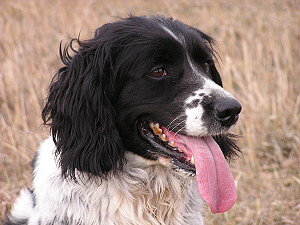  The concept of dominance and submissiveness in dogs has been debated widely by behaviorists, ethologists, and trainers, throughout the world. And there are almost as many definitions for each term as there are participants in the debate.
A Good Concept
I support the concept but prefer the term "subordinance" over "submissiveness". It conveys status or rank and is more clear-cut than "submissiveness," which is an attitude and attitudes are more vulnerable to interpretation. I believe we should examine a canine's standing in the pack separately from the behaviors it shows in occupying that position. Even simpler is to use the terms "higher-ranking behavior" or "lower-ranking behavior" to discuss a
dog's vocal and non-verbal behavior during interactions and transactions with others -- including humans.
Hierarchical Drive
Canines, in their natural state, live in packs and often engage in inter-dependent and cooperative behavior when hunting. Many breeds of domesticated dogs still carry a considerable amount of that innate drive toward maintaining a hierarchy. In this role, either the pack retains its stability, or individual members actively assert or forfeit rights. The outcome gives them a higher status in the pecking order - or a lower one - depending on the outcome.
Domesticated dogs' relationships with others (humans and other animals) constitute a hierarchy. Some owners find it difficult to figure out the pack order when other species are involved, and some don't feel their dog has a very strong hierarchical drive. They may be right... at least until behavior problems begin to occur.
When first asked, most owners would not say their dogs' behavior problems are dominance-based. They may not see a correlation between what the dog is doing that they don't like, and what they, the owners, do when they interact with the dog. Yet, when dogs have a clear-cut understanding of who is in charge, their behavior problems are more readily resolved.
For example, the dog barks to be let out to relieve itself. The owner acquiesces. Outcome? The dog learns that barking controls the owner's behavior. Soon the dog tries barking when he wants to be fed. If the owner complies, the dog learns once again that barking gets results. Soon the owner is seeking behavioral advice for "the dog's problem" and failing to recognize that his or her own behavior - allowing the dog to take a dominant role in the
relationship by controlling the owner - is at the root of the problem. It's not a barking problem; it's a problem of who's in charge.
An Imbalance
While what we are seeing is a dominance-subordinance imbalance, owners are more accepting of the idea when it is presented to them as a problem with "leadership and followership". This is a concept supported in the work of Mech, Schenkel, and other researchers into canine behavior and ethology.
Owners deal with this concept more readily than they can with the possibility that they are being dominated by their animals. Furthermore, this approach removes the stigma associated with the various connotations of such words as "dominant", "submissive" or "subordinate."
"...when dogs have a clear-cut understanding of who is in charge, their behavior problems are more readily resolved."
Leadership Skills
Most important, an owner's ability to dominate his or her dog may have very little to do with success in resolving most canine behavior problems. However, leadership skills - as dogs use them - are another story.
Dominance behaviors are implicitly threatening and their outcome depends upon a submissive response. Acquiescence in one instance does not mean the dominated dog will follow the other dog's leadership in future encounters. By contrast, leadership behaviors are generally non-threatening by nature and tend to enhance the likelihood of compliance in future encounters. Both are established and maintained through body language, vocalizations, behavioral
constancy, and other transactions. However, the outcomes are distinctly different.
Dominance is expressed primarily through intimidation and has a short-term effect that is closely linked to a specific situation or situations. In effect, the dominated dog is only likely to carry out the submissive behavior in the situations in which it was dominated. Even then, the dog is likely to test the situation again, before too long.
By contrast, leadership may include dominance behaviors, but is established more through transactions that build trust, bonding, a willingness to follow, and more. It tends to have a long-term effect and is far more stable than dominance.
In summary, I believe we should differentiate dominance from leadership, and recognize that most dogs don't need to be dominated, but all dogs need to be led. © 1987, 1997 -- Stephen C. Rafe. All Rights Reserved.
|
